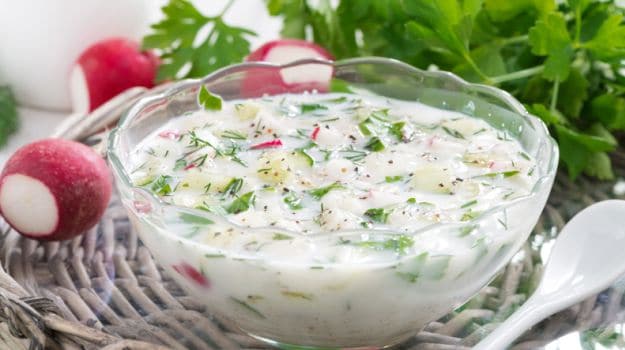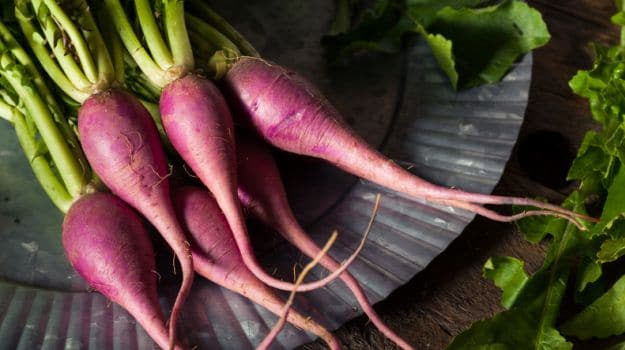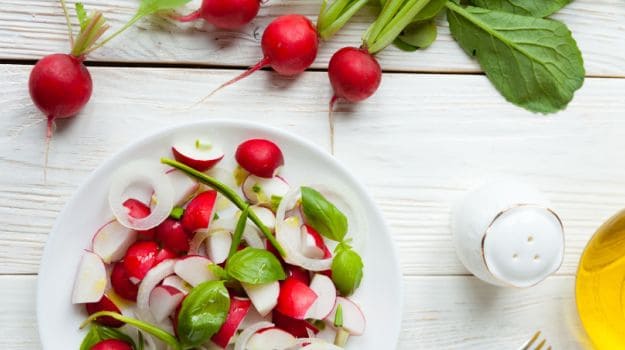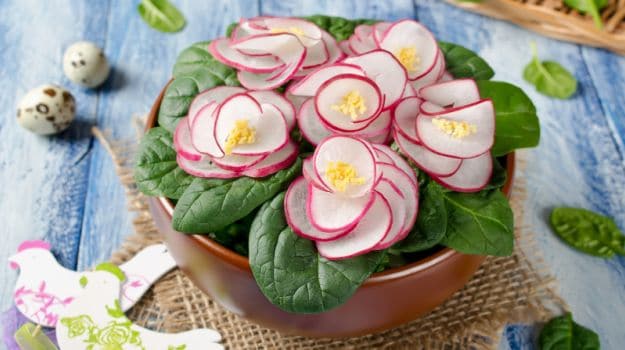Have you ever been conned to eat something you despise, and then actually grown to like it? My list is, or rather used to be, fairly long. And somewhere right on top was radish, or rather the humble mooli. It would take serious coercion to get me to eat it irrelevant of the various ways it was camouflaged - in a curry, parathas, dal, or even a salad.
Incidentally, there are various kinds of radishes with some growing in spring and summer, and some in winter. Daikon, the white variety most commonly found in India, is a spring-summer vegetable. The other varieties available in the country are the pink, and sometimes even the black. Now even though not everyone likes radish, it comes with a host of health benefits.
For instance, radish actually helps to cleanse our liver and stomach, thus detoxifying it; black radish and its leaves have been used for the longest time to treat jaundice because it can get rid of excess bilirubin. And because of that particular property, it also helps to purify our blood. They keep hypothyroidism in check too, thanks to its sulphur content.
 Radish benefits: Not many know of the benefits of this vegetable. Photo credits: iStock
Radish benefits: Not many know of the benefits of this vegetable. Photo credits: iStock
Let's take a look at some of the other benefits of this root vegetable:
1. Saves those RBCs: Radish is known to control damage to our red blood cells, and in the process also increases oxygen supply to the blood.
2. High on Fiber: If you eat it as part of your daily salad intake, without going overboard of course, radish also provides your system with ample roughage and fibers, therefore improving your digestion. It also regulates bile production, safeguards your liver and the gall bladder, and is great for taking care of water retention.
3. Guards the Heart: Radishes are a good source for anthocyanins that keep our hearts functioning properly, reducing the risk of cardiovascular diseases. Plus they are high on vitamin C, folic acid, and flavonoids too.
4. Controls Blood Pressure: Radish also provides your body with potassium, which can help lower your blood pressure, and keep your blood flow in control, especially if you are known to suffer from hypertension. According to Ayurveda, radish is believed to have a cooling effect on the blood.
 Radish benefits: Radish is enriched with fibre and Vitamin C. Photo credits: iStock
Radish benefits: Radish is enriched with fibre and Vitamin C. Photo credits: iStock
5. Improves Immunity: Given that the radish has high vitamin C, it can protect you from common cold and cough, and improve your basic immunity system. But you must consume it regularly. It also controls the development of harmful free radicals, inflammation and early ageing.
6. Fortifies Blood Vessels: Now this is important - radish plays an important role in the generation of collagen, which in turn boosts our blood vessels and decreases our chances of getting atherosclerosis.
7. Metabolism-Friendly: This root vegetable is not only good for your digestive system, but it also helps to fix acidity, obesity, gastric problems, and nausea, among others.
8. High on Nutrients: Red radishes are packed with Vitamins E, A, C, B6, and K. Plus it's high on antioxidants, fiber, zinc, potassium, phosphorous, magnesium, copper, calcium, iron and manganese. And each of these is known to keep our body in good working condition.
9. Good for the Skin: If you drink radish juice every day, you're giving your skin special boosters to stay healthy, and that's mostly because of the Vitamin C, zinc, and phosphorus. Plus it also keeps dryness, acne, pimples, and rashes at bay. Plus you can use radish paste to cleanse your face. And if you apply it on your hair, it helps to remove dandruff, prevent hair loss, and strengthens the root too.
10. Good for Hydration: If you tend to eat radish a little more in summer, it's probably because it keeps the body hydrated because of its high water content.
 Radish benefits: Radish comes in a number of regional varieties. Photo credits: iStock
Radish benefits: Radish comes in a number of regional varieties. Photo credits: iStock
Cooking with Radish
Now if you thought there is only so much you could do with radish, you'd be wrong. Apart from slicing it really thin, almost like Carpaccio if you can, and serving it with salad, there are plenty of other ways to maximise this vegetable. From making chutneys (such as the famous mullangi pachadi, a famous Andhra chutney) and curries or a poriyal, to using it to stuff parathas, or even adding it to raita - the options are aplenty.
For instance, you can make slices of radish, mash avocado, and use generous smears of goat cheese and use it to fill delicious multigrain bread slices for a quick sandwich - the bite of the radish, and the subtle flavours from the avocado can be a good pairing. Plus there's always cheese to add to the taste. You can also make a delicious radish soup, in case you need something comforting. It requires a bit of work, but the end result is quite tasty. And this is just the beginning. For interesting radish recipes, click on 9 Best Radish Recipes.
 Radish benefits: You can eat the winter vegetable in a number of ways. Photo credits: iStock
Radish benefits: You can eat the winter vegetable in a number of ways. Photo credits: iStock
About the author:
Priyadarshini Nandy would love to call herself the writer who "divides her time between London and Prague", but being able to call both Bengaluru and Kolkata her home is equally gratifying. As an independent journalist, she writes about food, theatre, travel, and more food, for various publications - new age and old school.
Disclaimer:
The opinions expressed within this article are the personal opinions of the author. NDTV is not responsible for the accuracy, completeness, suitability, or validity of any information on this article. All information is provided on an as-is basis. The information, facts or opinions appearing in the article do not reflect the views of NDTV and NDTV does not assume any responsibility or liability for the same.
